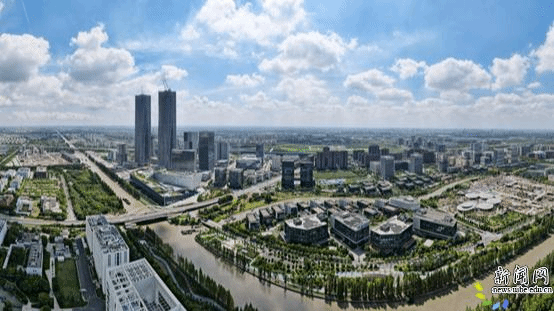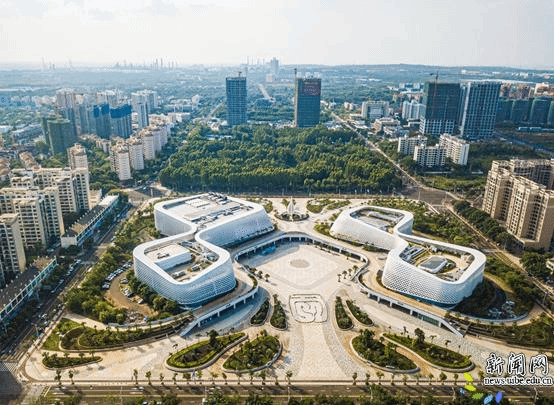(来源:《CGTN》2025-07-30)

A view of Zhangjiang area of the China (Shanghai) Pilot Free Trade Zone in east China's Shanghai. /Xinhua
Editor's note:The fourth plenary session of the 20th Communist Party of China (CPC) Central Committee is to be held in Beijing this October, a decision made at a CPC Central Committee Political Bureau meeting on Wednesday. CGTN launches the "China's economy: A new chapter unfolds" series. The first article focuses on China's opening-up. Yang Hangjun is a professor and associate dean at the School of International Trade and Economics, University of International Business and Economics. The article reflects the author's opinions and not necessarily the views of CGTN.
On July 15, 2025, Chinese President Xi Jinping, alsogeneral secretary of the Communist Party of China(CPC)Central Committeeand chairman of the Central Military Commission, published an article in Qiushi magazine titled Unswervingly Advance High-Level Opening-Up, which systematically summarized the key remarks he has made on opening-up from December 2012 to April 2025.
With the upcoming fourth plenary session of the 20th CPC Central Committee, there is growing public attention on whether the push for high-level opening-up will unleash a new wave of institutional dividends.
Xi's renewed emphasis on high-level opening-up comes at a historic juncture where external headwinds and domestic structural transitions converge. The world is undergoing profound changes unseen in a century, with protectionist tools such as reciprocal tariffs and non-tariff barriers proliferating, trade restrictions increasing and global supply chains facing mounting disruption risks.
Despite the considerable achievements China has made in its opening-up process, it still faces challenges such as limited experience in handling trade frictions, insufficient international discourse power and weak capacity to shape global economic rules.
The path forward lies in achieving "three strategic transitions": from factor and goods-based opening to institutional opening; from pre-establishment access management to post-establishment regulatory alignment in rules, standards and supervision; and from passive rule-taker to proactive agenda-setter in multilateral frameworks.
Institutional opening-up is the master switch to breaking bottlenecks. Over the past four decades, China has promoted external opening primarily through gradual tariff reductions, broader market access and a more favorable business environment. Today, the core of high-level opening-up lies in deep alignment with international rules, regulations, management practices and standards, so that China's domestic institutions resonate with high-standard international trade rules.
This is not merely about expanding entries in a positive list; it entails a systematic overhaul in key areas such as subsidies, competitive neutrality, government procurement, digital trade and green standards.
Pilot free trade zones (FTZs) and the Hainan Free Trade Port serve as institutional "stress-testing platforms." The full customs closure of the Hainan Free Trade Port is scheduled to be launched on December 18, 2025. The convergence of its zero tariffs, low tax rates and simplified tax system with the first-line liberalization, second-line control customs framework is accelerating.

A view of the Yangpu Economic Development Zone in south China's Hainan Province. /Xinhua
The next step should be to grant Hainan greater autonomy in reforming digital trade and trade in services, encouraging bold experimentation, targeted breakthroughs and systematic integration. For instance, it could take the lead in piloting the nation's shortest version of a negative list for cross-border services trade, providing a Hainan model for scalable replication nationwide.
How to transform China's super-sized market into a global rule-shaping power is another issue of concern. With a population exceeding 1.4 billion and the world's largest middle-income group, China is a super-large market with immense potential. This not only serves as a powerful magnet for global investment but also represents a pivotal force in reshaping global economic governance.
By accelerating the construction of a unified national market, eliminating local protectionism and improving the efficient flow of goods and factors, China will further enhance its market influence and diffusion of its rule. Meanwhile, domestic enterprises should be encouraged to leverage market scale advantages, strengthen indigenous innovation and enhance global competitiveness to gain greater influence in international markets.
As Xi stated earlier, the question today is not whether to open up, but how to enhance the quality of opening up and strengthen internal-external synergies. The upcoming fourth plenary session of the 20th CPC Central Committee is expected to deliver a new round of top-level design and systemic policy deployment.
Looking ahead, China may promote high-level opening-up by upgrading its pilot FTZ strategies, implementing full customs closure of the Hainan Free Trade Port, and deepening integration with high-standard free trade agreement networks.
In the face of a volatile and complex global landscape, China must open its doors with greater courage and wisdom. Only in this way can it move from "following" to "running alongside" and ultimately "leading," injecting powerful momentum into Chinese modernization and contributing a greater "China increment" to global prosperity and development.
附原文链接:https://news.cgtn.com/news/2025-07-30/Exploring-pathways-to-break-through-toward-high-level-opening-up-1FqKbbKH2W4/p.html